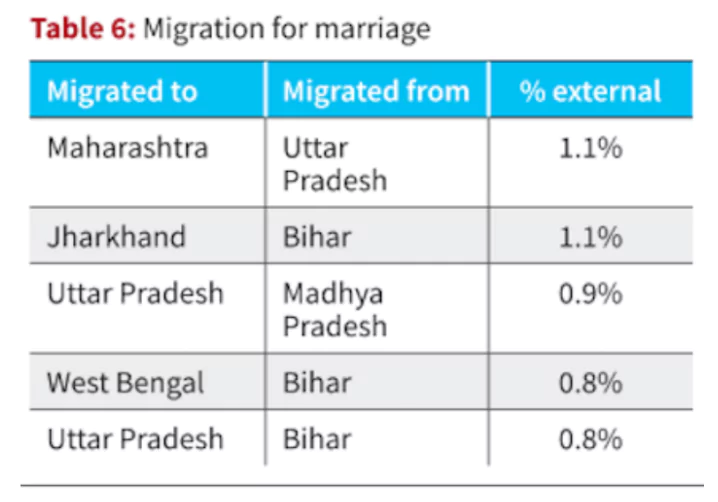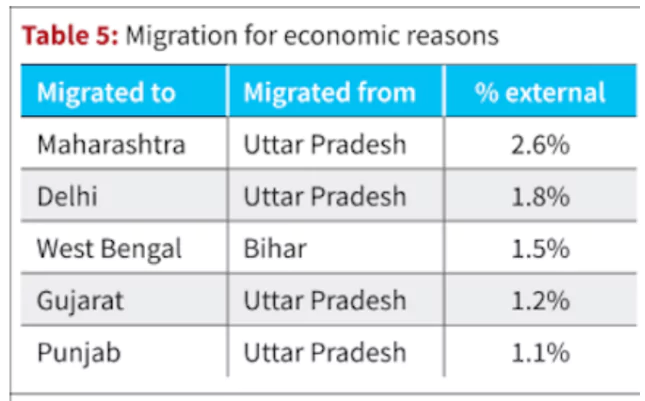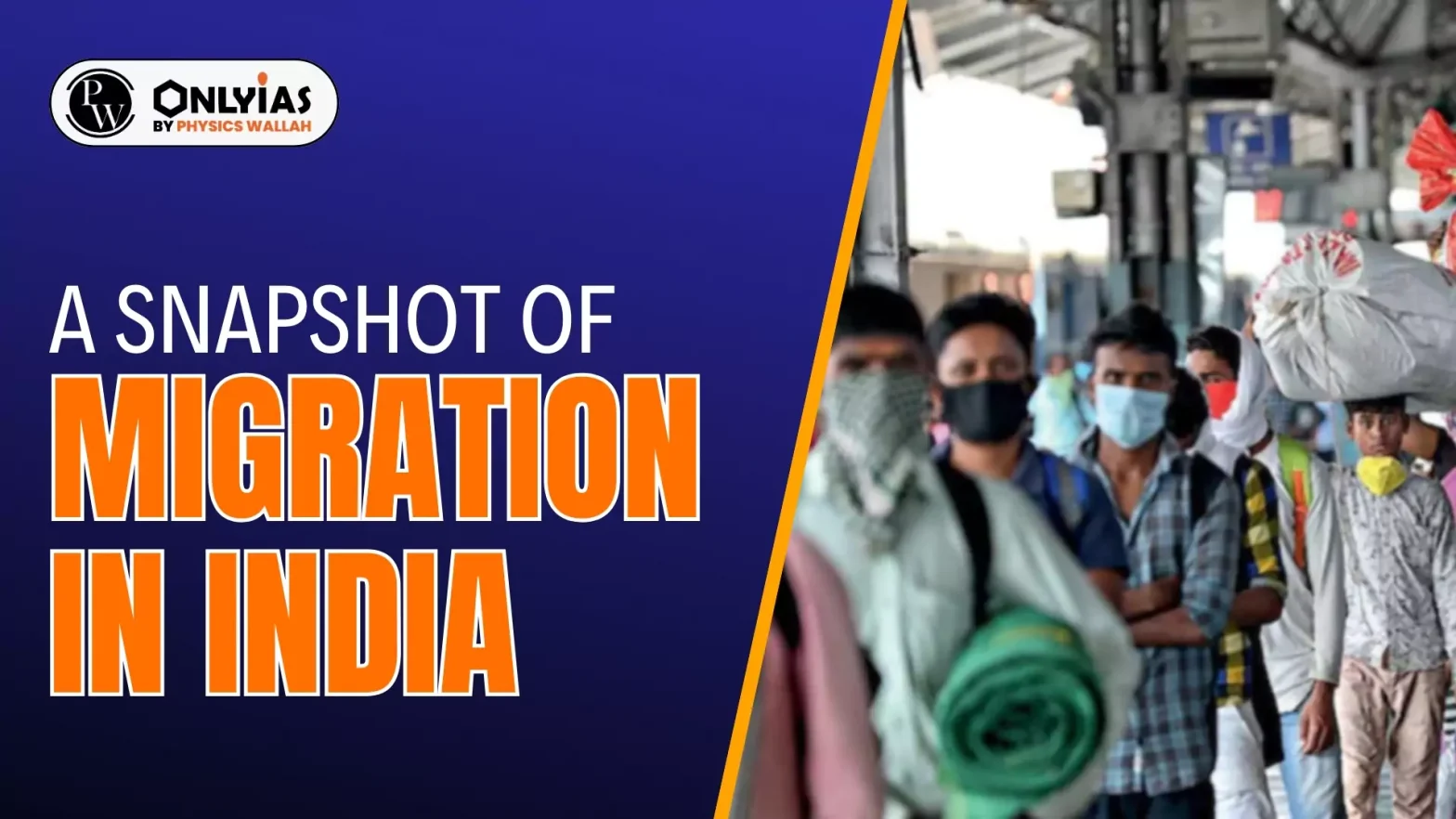The Multiple Indicator Survey of the National Sample Round, conducted in 2020-21, offers a detailed look at the reasons for intra and inter-State migration across India, and the problems faced by migrants
What’s Migration?
- Migration is the movement of people away from their usual place of residence, either internal (within the country) or international (across countries) borders.
- The terms “immigration” and “emigration” are used to refer to moves between countries (international migration).
Enroll now for UPSC Online Course
Intra-State Migration
- Intra-State migration refers to the movement of people within the same state or region.
- This can include migration from rural to urban areas, from one city to another, or even from one rural area to another within the same state.
Inter-State Migration
- Inter-State migration refers to the movement of people from one state to another within the same country.
- This type of migration can be more complex due to differences in language, culture, and economic conditions between states.
|
- Constitutional Provisions:
- Article 19: Migration within the country for work is a fundamental right of a citizen as upheld by Article 19 of the Constitution of India.
- Protection: The fundamental rights further prohibit human trafficking and guarantee freedom from discrimination based on place of birth, equal opportunities for employment, and protection from forced as well as child labour.
- Seventh schedule of the Constitution: Interstate migration comes under the seventh schedule of the Constitution, List I (Union List), entrusting the authority to the central government.
- Data on Migration: Maharashtra hosted the highest share of external migrants
-
- It’s followed by Uttar Pradesh, and West Bengal.
- Highest number of migrants: U.P. also contributed the highest number of migrants, followed by Maharashtra, West Bengal, and Bihar.
- If we look at pairs of regions: Migrants going from U.P. to Maharashtra formed the largest chunk of all external migrants
- It’s followed by migrants from the Gulf countries (some returning to Kerala), and migrants going from U.P. to Delhi.
- Hosts City: Suburban Mumbai remains the district that hosts the highest number of migrants
- It’s followed by Pune and Thane in Maharashtra.
Causes of Internal Migration in Indian
- Urbanization: Rural-urban migration is a major characteristic of urban transition in countries.
- The rates of urbanization influence rural-urban wage differences.
- An increase in the demand for labour in urban areas and better wages increase migration.
Check Out UPSC NCERT Textbooks From PW Store
‘Pull’ and ‘Push’ Factors
- Two principal factors– push and pull are responsible for migration.
- The push factors are poverty, lack of work opportunities, unemployment and underdevelopment, poor economic condition, lack of opportunities, exhaustion of natural resources etc.
- Pull factors attract migrants to an area (area of destination), like, employment and higher education opportunities, higher wages facilities, better working conditions.
|
- Marriage: Marriage is a very important social factor of migration. Every girl has to migrate to her in-law’s place of residence.
 Thus, the entire female population of India has to migrate over short or long distance.
Thus, the entire female population of India has to migrate over short or long distance.- Data: Marriage was one of the main reasons (68.2% of all reasons) for migration as well,
- Migrants from U.P. to Maharashtra, Bihar to Jharkhand, and Madhya Pradesh to U.P. accounting for the top three highest numbers
- Economic Reason: It includes better employment prospects, business, service transfers, etc.,
- Data: Among migrants moving States for economic reasons (who constituted roughly 22% of all reasons)
 Migrants going from U.P. to Maharashtra formed the largest chunk of all migrants
Migrants going from U.P. to Maharashtra formed the largest chunk of all migrants- It’s followed by those moving from U.P. to Delhi and from Bihar to West Bengal.
- Employment:
- The prime reason for migration from rural to urban areas and urban to urban areas is search for better employment in industries, trade, transport and services.
- People seasonally migrate for employment in different areas and different industries
- Agricultural work: Circular migrants are also attracted by agricultural work, such as the rice harvest season in West Bengal and the sugar cane harvest in Gujarat.
- Education: Due to lack of educational facilities in rural areas, people migrate to the urban areas for better academic opportunities. In the 2011 census, about 1.77% people migrated for education.
- Lack of security: Political disturbances and interethnic conflicts is another reason for internal migration.
- Environmental and disaster induced factors: There are migrants who are forced to move from rural to urban areas as a result of an environmental disaster that might have destroyed their homes and farms.
- People are also forced to migrate from their traditional habitats due to gradual deterioration of changing environmental conditions.
- There can also be forced displacement due to reasons such as developmental projects.
- According to a Lok Sabha Report, 2013 around 50 million people have been displaced in the name of development projects over 50 years in India.
Challenges Faced by Migrant Workers in India
- Employment in informal economy: Migrants dominate the urban informal economy which is marked by high poverty and vulnerabilities.
- In an unorganized and chaotic labour market, migrant workers regularly face conflicts and disputes at worksites.
- The common issues they face are non-payment of wages, physical abuse, accidents and even death at work.
- Issue of Identification documents: Proving their identity is one of the core issues faced by poor migrant labourers at destination areas.
- The basic problem of establishing identity results in a loss of access to entitlements and social services, such as subsidized food, fuel, health services, or education that are meant for the economically vulnerable sections of the population.
- Housing: Lack of affordable housing in Indian cities force migrants to live in slums.
- Many seasonal migrants are not even able to afford rents in slums force them to live at their workplaces (such as construction sites and hotel dining rooms), shop pavements, or in open areas in the city
- Financial Access: Migrant workers have limited access to formal financial services and remain unbanked
- Access to healthcare: Migrant workers have poor access to health services, which results in very poor occupational health.
- Education of children: UNESCO’s 2019 Global Education Monitoring Report (GEM Report) shows that children left behind by migrating parents and seasonal migrants face fewer educational opportunities overall.
- According to the report, 80% of migrant children across seven Indian cities did not have access to education near worksites.
- Among youth aged 15 to 19 who have grown up in a rural household with a seasonal migrant, 28% were identified as illiterate or had an incomplete primary education.
- Social exclusion: There is growing hostility of urban governments, as well as middle-class citizens, towards the urban poor, especially migrants to the cities.
- Political exclusion: Migrant workers are deprived of many opportunities to exercise their political rights.
- A 2011 study pointed out that 22% of seasonal migrant workers in India did not possess voter IDs or have their names in the voter list.
Enroll now for UPSC Online Classes
Measures Taken to Address Migration Challenges
- Inter-State Migrant Workmen (Regulation of Employment and Conditions of Service) Act of 1979: It seeks to address the unjust working conditions of migrant workers, including the necessity of gaining employment through middlemen contractors or agents who promise a monthly settlement of wages but do not pay when the time comes.
- Enhancing livelihood opportunities for rural population: The government from time-to-time has taken various initiatives to combat farmers’ distress and enhance livelihood opportunities in rural areas.
- Examples: Deendayal Antyodaya Yojana-National Rural Livelihoods Mission (DAY-NRLM), Mahatma Gandhi National Rural Employment Guarantee Act, Attracting and Retaining of Youth in Agriculture (ARYA).
- Infrastructure development in rural areas:
- RURBAN Mission: It seeks to stimulate local economic development, enhance basic services, and create well planned Rurban clusters (cluster villages).
- One of the main objectives is to reduce the rural-urban divide-viz: economic, technological and those related to facilities and service
- PURA (Providing Urban Amenities to Rural Areas): It seeks to tackle the problem of migration of people from rural to urban areas for employment.
- It seeks to develop technology in villages, provide better connectivity, enhance livelihood opportunities etc.
- SMART VILLAGES: It is a concept adopted by national, state and local governments in India, as an initiative focused on holistic rural development.
- The Eco Needs Foundation has initiated the concept of “Smart Village”.
- Under this project the Foundation is adopting villages and putting efforts for sustainable development by providing basic amenities like sanitation, safe drinking water, internal road, tree plantation, water conservation
![]() 22 Aug 2024
22 Aug 2024

 Thus, the entire female population of India has to migrate over short or long distance.
Thus, the entire female population of India has to migrate over short or long distance. Migrants going from U.P. to Maharashtra formed the largest chunk of all migrants
Migrants going from U.P. to Maharashtra formed the largest chunk of all migrants